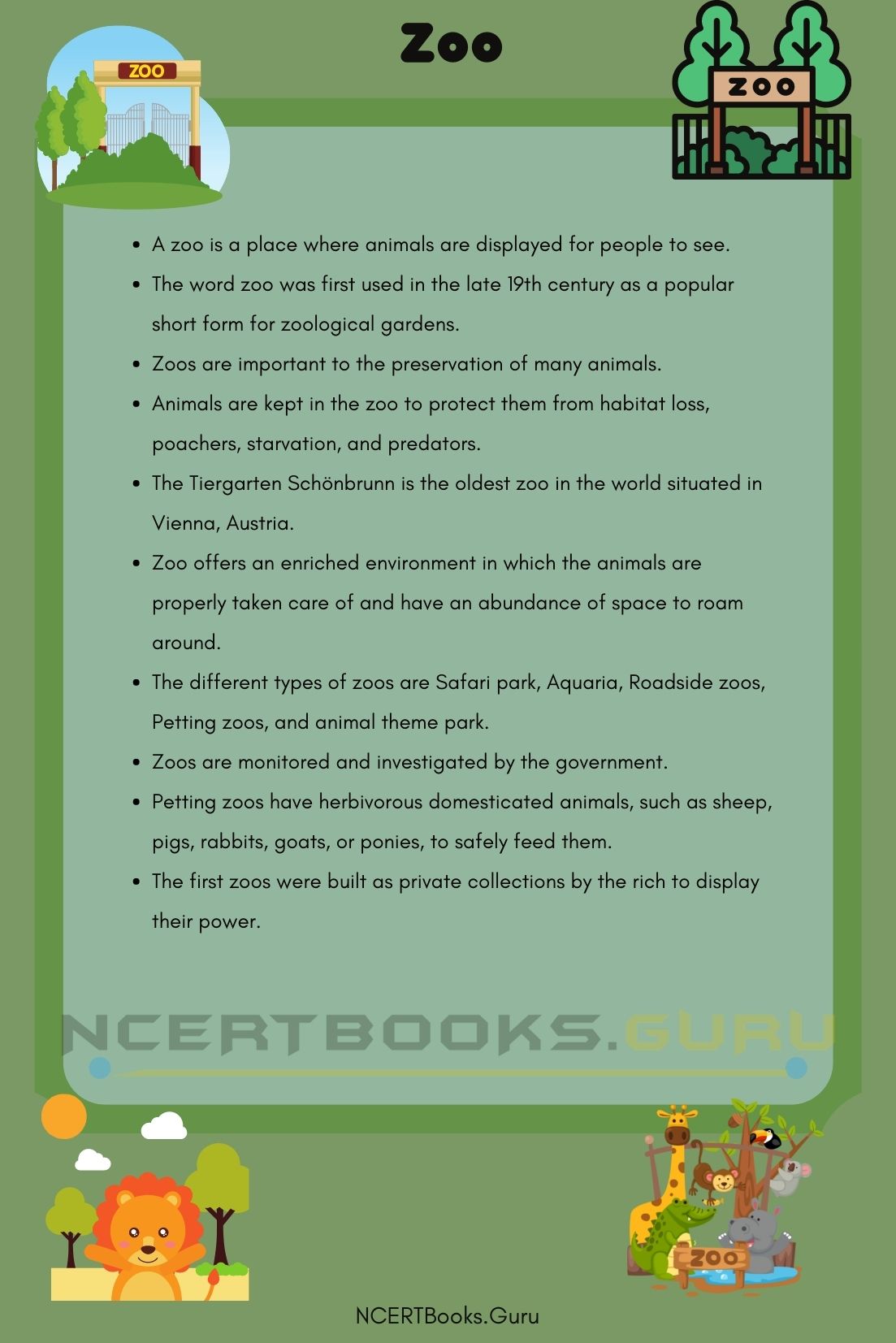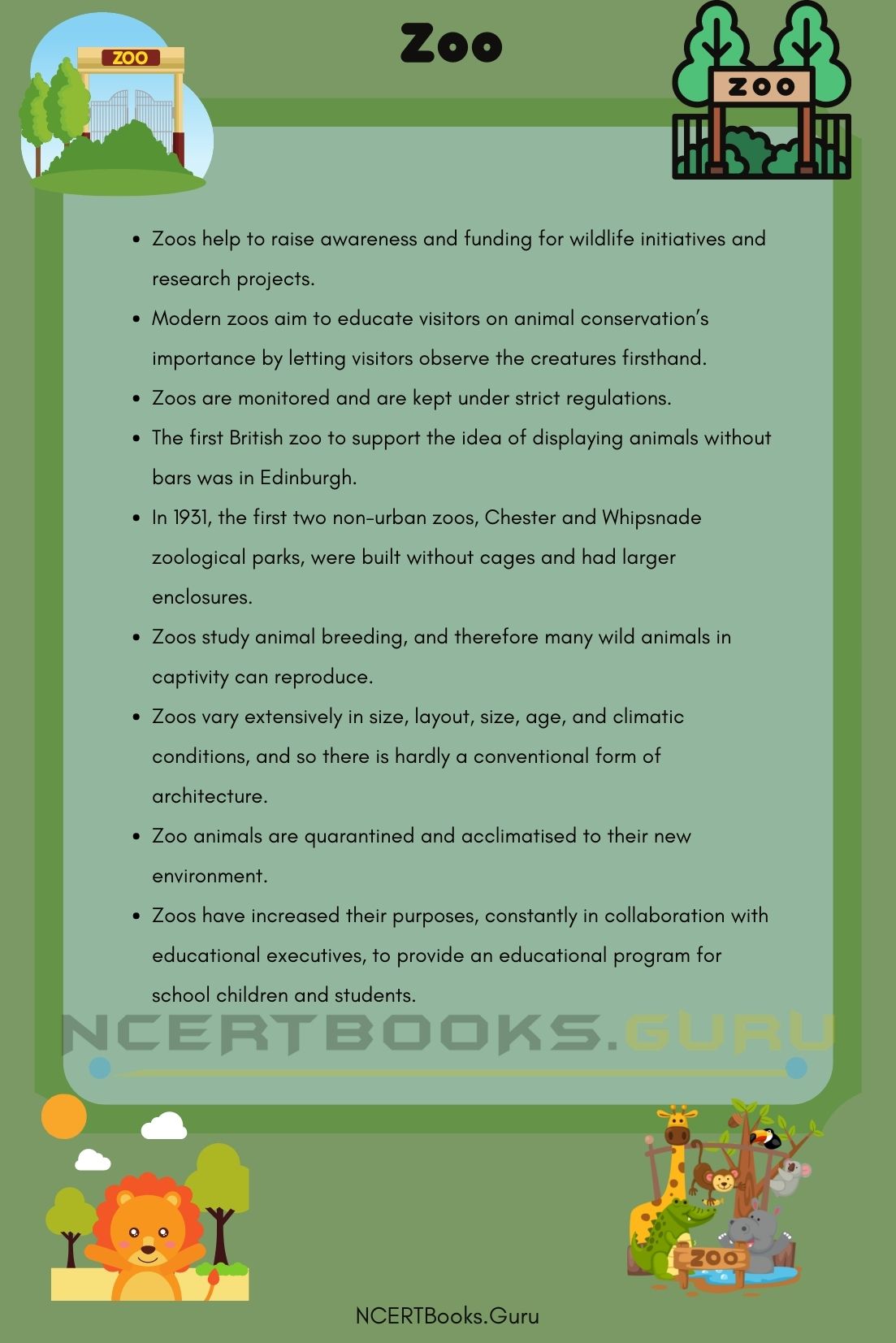10 Lines on Zoo: A zoo is a place where animals live and are displayed for people to see. The word “zoo” is abbreviated for “zoological park.” Zoos include wide types of animals that are native to all parts of the world.
Zoos preserve endangered species by bringing them into a secure environment, where they are shielded from habitat loss, poachers, starvation, and predators. Zoo offers an enriched environment in which the animals are never worn down, are properly taken care of, and have an abundance of space.
The first zoos were built as private collections by the rich to display their power. These private gatherings were known as menageries. Wall carvings, located in Egypt and Mesopotamia, reveal that leaders and kings founded menageries during the 2500 BCE. They left records of expeditions to distant countries to bring back extrinsic animals such as elephants, dolphins, giraffes, bears, and birds. Ancient zoo owners rented animal handlers to make sure their animals flourished and reproduced.
Early zoos focused on exhibiting as many unusual animals as possible in small, cramped conditions; most modern zoos’ focus is on conservation and education. Zoo’s bring about an unique debate, zoo conservationists argue that zoos’ are educational and protect endangered species while animal rights activists argue the violation of animal rights outweigh any perceivable benefits.
Enhance your vocabulary and writing skills with 10 Lines Essays available. Spark up the creativity in you and access various Topics on 10 Lines all in one place.
Set 1 – 10 Lines on Zoo for kids
Set 1 is considerate for students belonging to class one, two, three, four, and five
- A zoo is a place where animals are displayed for people to see.
- The word zoo was first used in the late 19th century as a popular short form for zoological gardens.
- Zoos are important to the preservation of many animals.
- Animals are kept in the zoo to protect them from habitat loss, poachers, starvation, and predators.
- The Tiergarten Schönbrunn is the oldest zoo in the world situated in Vienna, Austria.
- Zoo offers an enriched environment in which the animals are properly taken care of and have an abundance of space to roam around.
- The different types of zoos are Safari park, Aquaria, Roadside zoos, Petting zoos, and animal theme park.
- Zoos are monitored and investigated by the government.
- Petting zoos have herbivorous domesticated animals, such as sheep, pigs, rabbits, goats, or ponies, to safely feed them.
- The first zoos were built as private collections by the rich to display their power.

Set 2 – 10 Lines on Zoo for School Children
Set 2 is considerate for students belonging to class six, seven, and eight.
- Zoos accommodate many animals that are native to various parts of the world.
- The acronym “zoo” was first used by the London Zoological Gardens.
- In the year 1828, the London Zoological Garden was opened for scientific study, and in 1847, the zoo was opened to the public.
- Conservation park and bio park are some of the new terms for zoos in the late 20th century.
- In 1831, the Dublin Zoo was inaugurated by affiliates of a medical profession fascinated in studying animals while alive and, more particularly, getting hold of them when they were dead.
- Zoo animals live in enclosures that usually strive to replicate their behavioral patterns or natural habitats to benefit both the visitors and the animals.
- Zoos can be internment barracks for animals, but also a place of shelter.
- Zoos present wide collections of animals, such as primates, tropical birds, big cats, or waterfowl.
- Marine invertebrates, marine mammals, and fishes are usually stored in separate establishments known as aquariums.
- The modern ‘avatar’ of zoos emulates the natural settings as far as possible, allowing natural behaviours related to roaming and foraging.
Set 3 – 10 Lines on Zoo for Higher Class Students
Set 3 is considerate for students belonging to class nine, ten, eleven, twelve, and Competitive Exams.
- Zoos help to raise awareness and funding for wildlife initiatives and research projects.
- Modern zoos aim to educate visitors on animal conservation’s importance by letting visitors observe the creatures firsthand.
- Zoos are monitored and are kept under strict regulations.
- The first British zoo to support the idea of displaying animals without bars was in Edinburgh.
- In 1931, the first two non-urban zoos, Chester and Whipsnade zoological parks, were built without cages and had larger enclosures.
- Zoos study animal breeding, and therefore many wild animals in captivity can reproduce.
- Zoos vary extensively in size, layout, size, age, and climatic conditions, and so there is hardly a conventional form of architecture.
- Zoo animals are quarantined and acclimatised to their new environment.
- Zoos publish scientific periodicals and journals, ranging from the popular to the extremely technical.
- Zoos have increased their purposes, constantly in collaboration with educational executives, to provide an educational program for school children and students.

Frequently Asked Questions on Zoo
Question 1.
Define the term zoo.
Answer:
The term “zoo” is a short-form for “zoological park.”A zoo is a place where endangered species are preserved by bringing them into a secure environment.
Question 2.
When was the first public aquarium established?
Answer:
The first public aquarium was inaugurated at the London Zoo in 1853.Public aquariums are like zoos’ but house aquatic life species for the viewing of the public.
Question 3.
How did the zoo come into existence?
Answer:
The first zoos were built as private collections by the rich to display their power. These private gatherings were known as menageries. Wall carvings, located in Egypt and Mesopotamia, reveal that leaders and kings founded menageries during the 2500 BCE.
Question 4.
Illustrate the educational efforts of zoos.
Answer:
In recent years, a few zoos have expanded their efforts, in partnership with educational authorities, to implement an educational program for school children and students. Some zoos have full-time or voluntary guides on their staff, whose work provides more information for visitors than on labels attached to cages.
